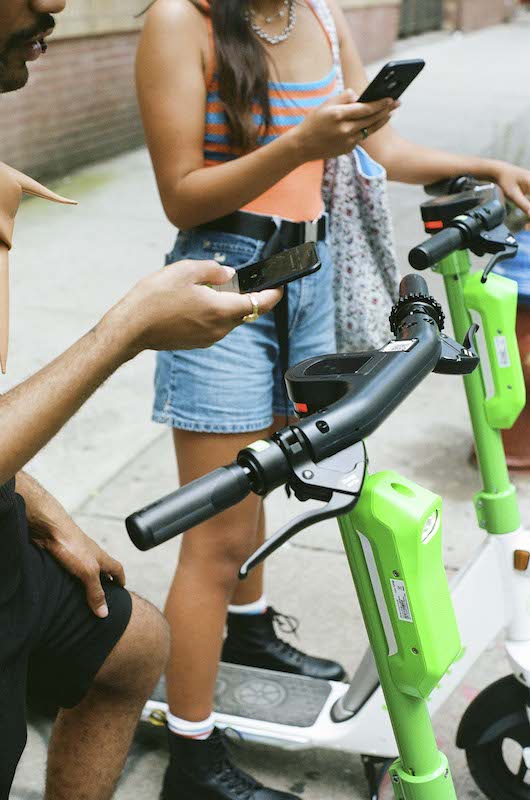Transportation contributes the largest share of climate change-causing carbon pollution in the United States and second-largest globally. The largest share of those emissions are from personal transportation. If we’re going to tackle the climate crisis, the single greatest threat to humanity, we have to rethink how we move people around.
Auto manufacturers are making significant progress in advancing electric vehicles (EVs) — from the early success of Ford’s popular F-150 Lightning to automakers investing in domestic battery production — but it’s important to go beyond electric cars and trucks and help people drive less, especially in urban areas. Globally, governments — from national to local — should prioritize alternative mobility options with policy and new investment to allow people to move around more efficiently.
The micromobility movement is growing rapidly, with people increasingly choosing e-bikes and e-scooters as a quick, convenient, affordable and scalable way to reduce transportation pollution while addressing the climate crisis. The best-selling EV in the U.S. in 2021 was actually the e-bike. The same was true in Europe.
These vehicles are getting faster, with longer-range batteries. In Paris, trips by car have dropped about 45 percent since 1990, and the share of cycling has increased tenfold. Meanwhile, cities around the globe, from Madrid to Chicago, are embracing shared systems that democratize access, offering thousands of affordable shared e-bikes and e-scooters.
We should reframe the conversation about the future of urban mobility from being car-centric to being carbon-centric.
These light EVs weigh half or even a quarter the weight of the passengers they move. In contrast, one rarely needs a 3- or 4-ton vehicle for most daily urban trips, especially when 60 percent of U.S. car trips are under 6 miles. These short-distance city trips are the sweet spot for e-bikes and e-scooters; modern electric motors and advances in battery technology make these options a game changer for more users. Because of their efficiency, many popular e-bikes can travel more than 2,000 miles on a single charge for the same price as a single gallon of gasoline. Micromobility is 10 times more important than widespread EV adoption, according to a recent Oxford study. Further, shared e-bikes and e-scooter programs have helped replace cars and reduce carbon for short trips, creating the potential for massive carbon pollution savings at scale.
Most cars and trucks sit idle 96 percent of the time and occupy scarce space in cities. Reducing our dependence on cars and transitioning to micromobility could also allow cities to transform garages into affordable housing, parking lots into parks and street parking into bike lanes and restaurant seating.

![]()
![]()
![]()
As gas prices rose to record highs last year, shared micromobility for the second time in two years emerged as a solution to a global crisis.
First, the pandemic put socially distant, open-air transportation at the forefront of safe mobility. Shared e-bike and e-scooter providers went from being viewed as tourist amenities to being deemed an “essential service” by cities worldwide. As streets were cleared of cars, cities from Seattle to Milan used the opportunity to enact generational infrastructure improvements for micromobility, including protected bike lanes and car-free streets that remain to this day.
Meanwhile, today the global shockwaves in energy supply caused by Russia’s invasion of Ukraine spiked gas prices. Average U.S. gas prices rose to an all-time high of more than $5 a gallon. In San Diego, where gas prices reached $5.74, total trips with Lime’s shared e-scooter and e-bike service increased 35 percent week over week. In Los Angeles, prices were even higher at an average of $6.11 per gallon last spring. High gas prices aren’t just driving up micromobility ridership. Cities such as Omaha, Nebraska, experienced soaring levels of bus ridership, too.
Finally, beyond the pandemic and war in Ukraine, the slower-burning crisis of climate change offers yet a third rationale in so many months begging for a two-wheeled, micromobility revolution.
With these smaller EVs providing a path forward in decarbonizing mobility, there are things we can do to accelerate this transition:
- We should invest in infrastructure for micromobility vehicles. In the U.S. and around the globe, infrastructure investments help make riders feel safer, spurring ridership. Surveyed Lime riders consistently cite improved safety and infrastructure as an impetus to spark even more mass adoption. As part of the $1 trillion infrastructure bill approved by Congress, $6.4 billion is being used to fund projects to reduce greenhouse gas emissions, including pedestrian and bike lane projects to encourage mode shift from cars in cities.
- Even with the very promising carbon initiatives in the recent Inflation Reduction Act, incentives for bikes, e-bikes and e-scooters were left on the chopping block. As lawmakers consider future modifications to tax credits for EVs, they ought to support tax credits for micromobility. These smaller, more efficient vehicles can be deployed faster at a lower cost.
- We should reframe the conversation about the future of urban mobility from being car-centric to being carbon-centric. If we envision the outcomes we want in both carbon reduction and in developing more people-first cities, we’ll be able to right-size policy to the human scale.
It’s time to begin treating micromobility with the outsize impact it can have on carbon. It might be one of the few silver bullets out there to address the climate crisis.
- SEO Powered Content & PR Distribution. Get Amplified Today.
- Platoblockchain. Web3 Metaverse Intelligence. Knowledge Amplified. Access Here.
- Source: https://www.greenbiz.com/article/future-electric-transportation-can-be-led-2-wheels



